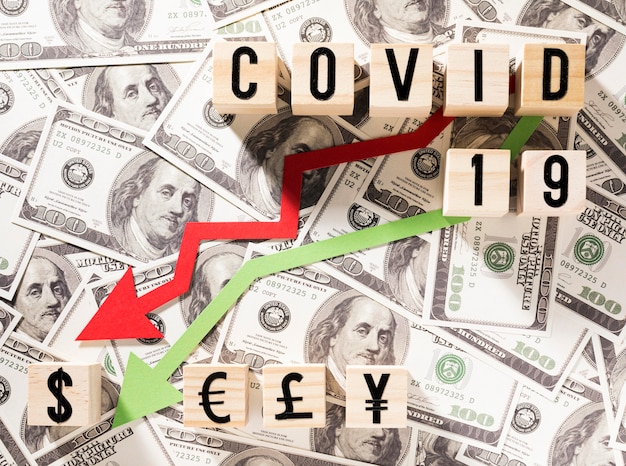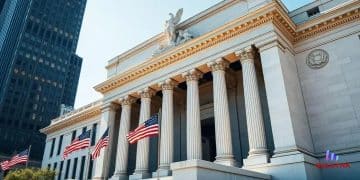National Debt Alert: How 130% of GDP by 2025 Impacts Your Investments

The U.S. national debt is projected to reach 130% of GDP by 2025, potentially impacting investments through inflation, interest rate hikes, and market volatility, while also affecting government spending and economic growth.
The looming projection of the national debt reaching 130% of GDP by 2025 is sending ripples through the financial world. The implications for your investments are significant and demand careful consideration. This article explores how this escalating debt could reshape the investment landscape.
Understanding the U.S. National Debt and GDP
To grasp the potential impact of the national debt reaching 130% of GDP, it’s crucial to understand these fundamental concepts and their relationship. The national debt represents the total amount of money the U.S. federal government owes to its creditors.
What is the National Debt?
The national debt accumulates over time as the government spends more than it collects in revenue, resulting in a budget deficit. This deficit is then financed by borrowing money through the issuance of Treasury securities.
What is GDP?
Gross Domestic Product (GDP) is the total monetary or market value of all the finished goods and services produced within a country’s borders in a specific time period. It serves as a comprehensive scorecard of a country’s economic health.
The debt-to-GDP ratio is a useful metric for assessing a country’s ability to repay its debt. Here are some factors that can impact the debt to GDP ratio:
- Government Spending: Increased government spending without a corresponding rise in revenue can increase the debt.
- Economic Growth: A growing economy (higher GDP) can make the debt more manageable.
- Interest Rates: Higher interest rates increase the cost of borrowing, adding to the debt.
- Tax Policies: Changes in tax laws can affect government revenue and, consequently, the debt.
In conclusion, understanding the U.S. national debt and GDP, and particularly their ratio, is vital for assessing the nation’s financial health and predicting potential impacts on investments.

How a High National Debt Could Affect the Economy
A national debt reaching 130% of GDP isn’t just an abstract number; it carries significant implications for the overall health of the economy. Understanding these potential consequences is crucial for investors.
Inflationary Pressures
One of the major concerns is inflation. When the government finances its debt by printing more money, it can lead to a devaluation of the currency and a rise in the general price level.
Impact on Interest Rates
To attract investors and manage inflation, the government might need to offer higher interest rates on its debt. This can lead to increased borrowing costs for businesses and consumers, potentially slowing down economic activity.
A high national debt can create a vicious cycle of economic challenges. Here are some of the cycles to consider:
- Reduced investment: High debt can discourage both domestic and foreign investment, as investors become wary of the country’s financial stability.
- Slower economic growth: Reduced investment can lead to slower economic growth, making it even harder to manage the debt.
- Increased risk of financial crisis: In extreme cases, a high national debt can increase the risk of a financial crisis, as investors lose confidence in the government’s ability to repay its obligations.
In conclusion, a high national debt reaching 130% of GDP is a serious concern with the potential to trigger inflation, raise interest rates, and stifle economic growth, all of which can have substantial ramifications for investors.
Potential Effects on Different Asset Classes
The projected national debt increase can ripple through various asset classes, impacting their performance in both positive and negative ways. Investors need to understand these potential shifts to make informed decisions.
Stocks
The stock market’s reaction to a rising national debt can be complex. Initially, government spending might stimulate economic activity, boosting corporate earnings and driving stock prices higher. However, as inflation rises and interest rates climb, the positive effects may diminish.
Bonds
Bonds are directly affected by the national debt. As the government issues more debt, bond prices can fall, especially if investors demand higher yields to compensate for the increased risk of holding government debt.
Real Estate
Real estate can be a mixed bag. On one hand, as inflation rises, real estate can act as a hedge, as property values and rents tend to increase with inflation. On the other hand, higher interest rates can make mortgages more expensive, dampening demand and potentially leading to a slowdown in the housing market.

Diversification becomes more critical in an environment of high national debt and economic uncertainty. Here are some strategies to leverage:
- Asset Allocation: Spreading investments across different asset classes can help mitigate risk.
- Geographic Diversification: Investing in international markets can reduce exposure to the U.S. economy.
- Alternative Investments: Consider investments like commodities, private equity, or hedge funds, which may perform differently from traditional assets.
In summary, the national debt’s potential impact varies across asset classes, influencing stocks, bonds, and real estate differently, emphasizing the need for diversification and strategic asset allocation.
Strategies for Investors to Navigate the Debt Crisis
Given the potential challenges posed by the rising national debt, investors need to adopt proactive strategies to protect their portfolios and capitalize on emerging opportunities. Prudent financial planning is paramount.
Rebalancing Portfolios
Regularly rebalancing your portfolio ensures that your asset allocation aligns with your risk tolerance and investment goals. In a volatile environment, it is especially important to maintain your desired balance.
Considering Inflation-Protected Securities
Treasury Inflation-Protected Securities (TIPS) are designed to protect investors from inflation. The principal of TIPS increases with inflation and decreases with deflation, as measured by the Consumer Price Index.
Focusing on Value Investing
Value investing involves identifying undervalued companies with strong fundamentals. These companies often have the potential to outperform in the long run, regardless of the overall economic environment.
A proactive approach to financial planning is essential for navigating the uncertainties. Here are vital actions to take:
- Consult a Financial Advisor: A financial advisor can help you assess your risk tolerance, investment goals, and financial situation, and develop a customized investment plan.
- Stay Informed: Keep abreast of economic developments and market trends, and be prepared to adjust your strategy as needed.
- Have a Long-Term Perspective: Avoid making rash decisions based on short-term market fluctuations. Focus on your long-term goals.
In conclusion, investors can navigate the challenges of the rising national debt by rebalancing portfolios, considering inflation-protected securities, focusing on value investing, and engaging in proactive financial planning.
Historical Examples of High Debt-to-GDP Ratios
Examining countries with high debt-to-GDP ratios throughout history can offer valuable insights into potential economic outcomes and inform investment strategies. Learning from the past helps to anticipate the future.
Japan
Japan has maintained a high debt-to-GDP ratio for decades, largely due to persistent deflation and aging demographics. While the Japanese economy has faced challenges, it has avoided a complete collapse, partly due to its strong domestic savings rate and unique economic structure.
Greece
The Greek debt crisis in the early 2010s serves as a cautionary tale. Excessive government spending and a lack of fiscal discipline led to a sovereign debt crisis that required international bailouts and austerity measures. The crisis severely impacted the Greek economy and its citizens.
Italy
Italy has also grappled with a high debt-to-GDP ratio, which has contributed to concerns about its economic stability. Political instability and structural issues have made it difficult for Italy to implement reforms and reduce its debt burden.
Key lessons emerge when we analyze historical precedents:
- Fiscal Discipline is Crucial: Countries that maintain fiscal discipline and control government spending are better able to manage their debt.
- Structural Reforms are Needed: Addressing structural issues, such as labor market rigidities and inefficient bureaucracy, can boost economic growth and reduce debt.
- External Support Can Provide Relief: In some cases, external support from international institutions or other countries can help mitigate the impact of high debt.
In summary, historical examples like Japan, Greece, and Italy demonstrate that managing a high debt-to-GDP ratio requires fiscal discipline, structural reforms, and sometimes external support, with varying degrees of success.
The Role of Government Policy and Fiscal Responsibility
Government policy and fiscal responsibility play a pivotal role in managing the national debt and mitigating its potential impact on the economy and investments. Sound governance is essential.
Importance of Fiscal Responsibility
Fiscal responsibility involves making prudent decisions about government spending and taxation. It means balancing the budget, controlling debt, and investing in areas that promote long-term economic growth.
Potential Policy Responses
To address the rising national debt, the government could implement various policy responses, such as tax increases, spending cuts, and entitlement reforms. Each of these measures has its own set of economic and political consequences.
Impact of Political Factors
Political factors can significantly influence fiscal policy. Partisan gridlock and conflicting priorities can make it difficult to reach consensus on how to address the debt, leading to inaction or suboptimal policies.
Accountability and transparency are crucial for effective governance. Here are some steps that stakeholders should perform:
- Transparency in Budgeting: Governments should provide clear and transparent information about their budget and debt levels.
- Independent Audits: Independent audits can help ensure that government spending is efficient and effective.
- Citizen Engagement: Engaging citizens in the budget process can help ensure that government policies reflect their priorities.
In conclusion, government policy and fiscal responsibility are critical for managing the national debt. Effective governance requires making prudent decisions, implementing appropriate policies, and ensuring accountability and transparency.
| Key Aspect | Brief Description |
|---|---|
| 💰 Debt-to-GDP Ratio | Ratio projected to hit 130% by 2025, indicating significant national debt relative to economic output. |
| 📈 Economic Impacts | Potential for increased inflation, higher interest rates, and slowed economic growth. |
| 🛡️ Investor Strategies | Rebalancing portfolios and diversifying assets crucial for risk management. |
| 🏛️ Government Role | Fiscal responsibility, policy responses, and economic transparency are essential. |
Frequently Asked Questions
▼
It indicates that a country’s national debt is 130% of its annual economic output. It suggests the country may struggle to pay back debts without economic reforms.
▼
Large debts can lead to increased money printing, devaluing currency and raising prices. If more money chases the same amount of goods, prices rise.
▼
Treasury Inflation-Protected Securities (TIPS) protect against inflation. TIPS’ principal value adjusts with inflation, maintaining real value of the investment.
▼
Diversification spreads risk across different assets. If one asset underperforms due to debt issues, others can provide stability and potential growth.
▼
Fiscal policy involves government spending and taxation. Responsible policies help balance budget, control debts, and promote long-term economic stability.
Conclusion
The projected increase in the national debt to 130% of GDP by 2025 presents significant challenges for investors. Vigilance, strategic planning, and a diversified investment approach are essential to navigate these uncertain times and protect your financial future.





